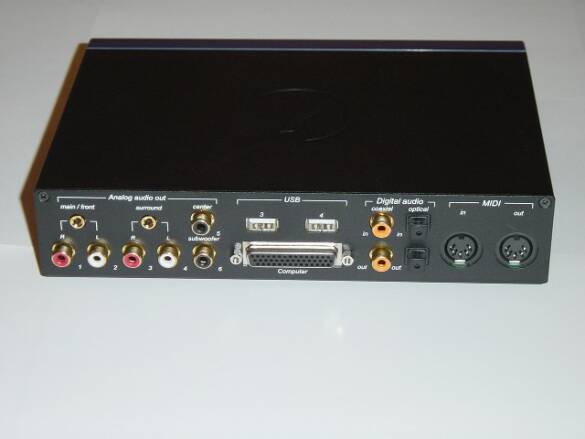More Than A SoundBlaster
Hercules - Game Theater XP, Continued
When you first pick up the Game Theater XP, the first thing that you will notice is that the box is heavy. Weighing in at more than five pounds, this is no light weight product. Most of the weight comes from the well constructed External Rack which is in fact made of metal, something that is becoming more rare in the plastic world of today. Some of the weight also can be attributed to the large shielded DB-44 cable that connects the External Rack to the Game Theater XP card itself.
The manual included with the Game Theater XP is translated into three languages: English, French, and Spanish. It contains about fourteen pages in each language and covers the General Specifications of the sound card itself, physical hardware installation, driver installation for 95/98/98SE/ME/2000, Software Installation, and Sound Board Configuration. As with the manual that was included with the Gamesurround Fortissimo II, I found the manual to be very basic at best, which is unfortunate, because this is a more complex product than the Gamesurround Fortissimo II, and I really felt that the manual should have gone into more depth. Like the Gamesurround Fortissimo II manual, the pictures and screen shots in the manual are small and hard to read. In fact, some of the screen shots are so small that if you are looking at them for guidance to help you, you will also, literally, need a magnifying glass. The Software Installation section of the manual does not really provide much information about the installation of the applications; instead, it refers you to the online HTML documentation included with the CD.
The bracket of the card itself only has a DB-44 connector that runs between the External Rack and the card. This means that if you want to output any kind of sound at all out of your PC, you must have the External Rack connected to the card. I guess this works in most situations, but I really think that Guillemot missed the mark here. I would have really liked for them to include perhaps a second headphone output, or even a second standard speaker output on the bracket of the card. If you take your computer to a LAN party or anywhere, for that matter, the External Rack and cable is just one more thing to have to carry, so the convenience of the External Rack does come at a small cost.
Something that Guillemot did get right was to include a four port un-powered USB hub into the External Rack. Once you run the included USB cable from the External Rack to your PC, you now have the use of four USB ports for any un-powered USB device that you wish to plug into these ports. Creative should take a lesson here and try to incorporate this into a future design of the Live! Drive. If you are a big USB user with limited ports, this can save you the $20 cost of a four port USB hub.
When you see the staggering array of connectors on the Game Theater XP, you will notice that Guillemot didn't leave anything out. The External Rack features input and output connectors on both the back and front of the External Rack, which allows you to hide some of those cables. This is, of course, in stark contrast to the Live! Drive, which almost forces you to have some cables running out of the front of your PC. In normal situations, as we stated in the Live! Review, this isn't an issue because the cables might not be in long-term use, but if they are, they can get in the way of other 3.5" and 5.25" devices in the other bays. This can also be a pain with 3.5" and 5.25" devices that have removable media. With the design of the Game Theater XP's External Rack, you can keep those devices connected to your PC long term and not have to worry about a mess of cables spewing from the front of your PC.
Get Tom's Hardware's best news and in-depth reviews, straight to your inbox.
Current page: Hercules - Game Theater XP, Continued
Prev Page Hercules - Game Theater XP Next Page Hercules - Game Theater XP, Continued